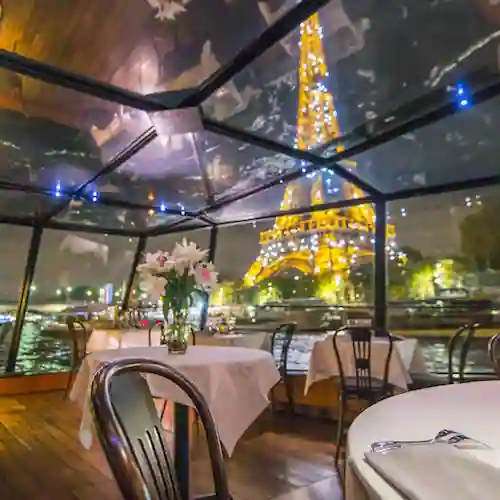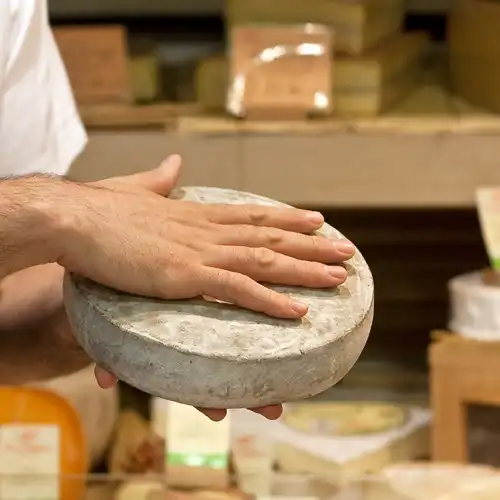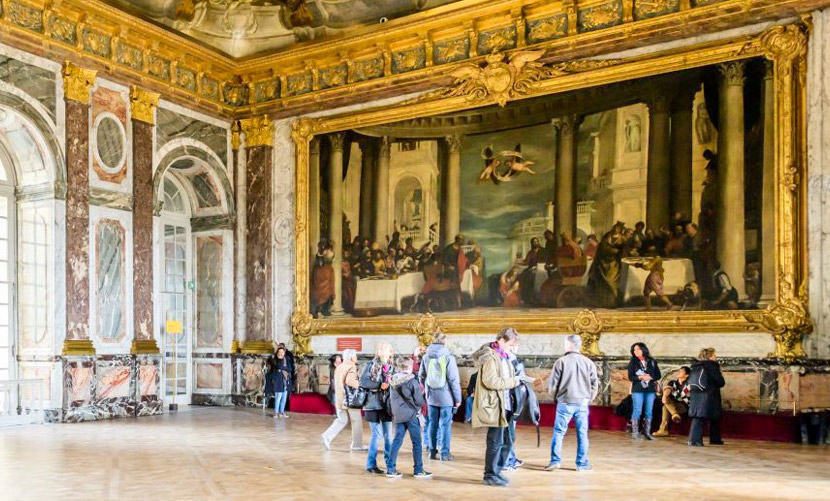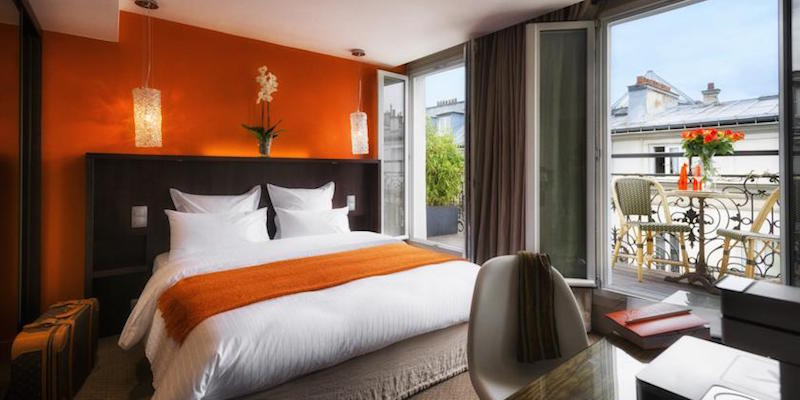8 Remarkable Fountains That Helped Create Paris
It might not be obvious, but Paris is a city built on water and fountains. For centuries fountains supplied drinking water to the thirsty city. Napoleon (it's always about Napoleon, isn't it?) realized how important fountains were in providing clean water to Parisian; he decreed that water should flow day and night and be freely available to all. Bonaparte established programs to clean and restore existing fountains plus commissioned fifteen additional fountains.
![]()
Our Top-Rated Paris Experiences
Thousands of Fountains
 What goes on beneath the fountains of Paris, photo by Mark Craft
What goes on beneath the fountains of Paris, photo by Mark Craft
Once you start to pay attention, you realize that the fountains of Paris remain major sights, even today. There are thousands of working fountains and decorative fountains dotting the Parisian landscape. Let's take a look at eight fountains of Paris that you might want to add to your planning map for your next H2O tour of the City of Water.
![]()
Discover What's On When You're Here...
• January... |
• February... |
• March... |
• April... |
• May... |
• June... |
• July... |
• August... |
• September... |
• October... |
• November... |
• December... |
Discover What's On When You're Here
• January...
|
• February... |
• March... |
|---|---|---|
• April... |
• May... |
• June... |
• July... |
• August... |
• September... |
• October... |
• November... |
• December... |
8 Remarkable Fountains of Paris
1. Fontaines de la Concorde, 1836-1840
 Fountains on Place de la Concorde, with La Madeleine in the distance
Fountains on Place de la Concorde, with La Madeleine in the distance
There are two majestic fountains that steal the show at Place de la Concorde. Completed in 1840 when Louis-Philippe, the last king of France, reigned supreme, the Maritime Fountain (the one closest to the Seine) honors maritime commerce while the Fountain of the Rivers, to the north, pays tribute to the abundance of the Rhône and the Rhine rivers.
- Place de la Concorde
- 1st Arrondissement
- Metro – Concorde
2. Fontaine des Quatre-Saisons, 1739
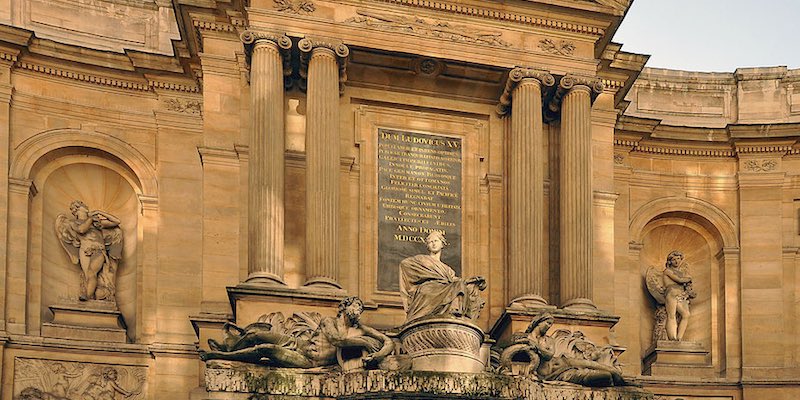 Fontaine des Quatre-Saisons, photo Wikimedia by Moonik
Fontaine des Quatre-Saisons, photo Wikimedia by Moonik
We have Edme Bouchardon, royal sculptor to Louis XV, to thank for creating this richly decorated and ornate fountain celebrating the four seasons. In his proposal Bouchardon described the principal figure, a well-dressed and majestic woman to represent the City of Paris. In one hand, she holds the prow of a vessel while on her head she wears a crown. A figure at her side represents the Seine, another figure represents the Marne river.
The structure's four bas-relief figures represent Les Genies des Seasons, The Spirits of the Seasons. Bouchardon's intention was to show the abundance of Paris witnessed in every season of the year. When you're here, make sure to study the fine bas-reliefs representing spring, summer, autumn, and winter. (You may have to tip your head back quite a bit. Rue de Grenelle is a pretty narrow street at this point.)
- 57-59 Rue de Grenelle
- 7th Arrondissement
- Metro – Rue du Bac
![]()
|
Escape to the Land of Bubbly on a small-group day tour from Paris. Taste at top Champagne houses, meet boutique producers, enjoy a leisurely lunch, and toast to a perfectly sparkling day. |
|
Escape to the Land of Bubbly on a small-group day tour from Paris. Taste at top Champagne houses, meet boutique producers, enjoy a leisurely lunch, and toast to a perfectly sparkling day. |
3. Fontaine des Innocents, 1550
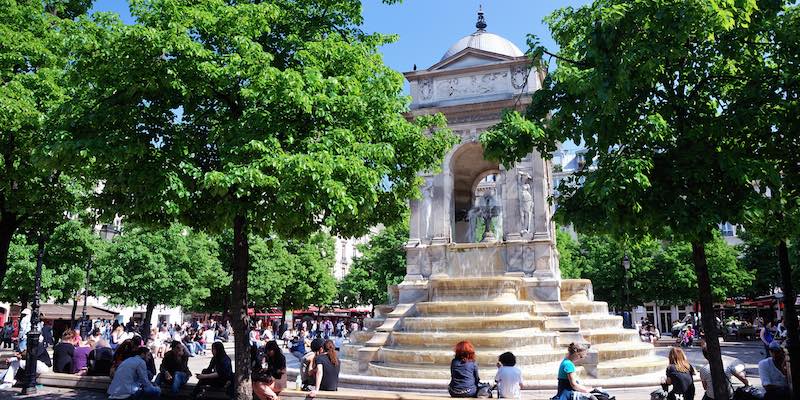 Fontaine des Innocents in the 1st Arrondissement
Fontaine des Innocents in the 1st Arrondissement
This fountain on Place Joachim-du-Bellay, originally named the Fountain of the Nymphs, was completed in 1550, making it the oldest monumental fountain in Paris. It was built to commemorate the royal entry of Henry II into the city and was royal sculptor Jean Goujon's most important commission. The fountain was originally built on Rue Saint Denis, one of the oldest streets in Paris. It has been moved a few times since then, finally settling in its current location in the Marais near Les Halles.
- Place Joachim du Bellay
- 1st Arrondissement
- Metro – Les Halles
4. Fontaine de Mars, 1806
 Fontaine de Mars on Rue Saint-Dominique, photo by Mark Craft
Fontaine de Mars on Rue Saint-Dominique, photo by Mark Craft
Napoleon appointed the polymath François-Jean Bralle — designer, architect, hydraulic engineer — to build fifteen new fountains, starting in 1806. One of these is the Fontaine de Mars, still in its original location on Rue Saint-Dominque. Although it's not apparent today (due to subsequent building construction) the fountain is near Les Invalides, the military hospital, and so was named for the Roman god of war. A bas-relief sculpture of the god appears on the fountain as does a sculpture of Hygieia, goddess of health.
The fountain is located on a small place that is flanked by two restaurants that honor the location. Restaurant Fontaine de Mars is one of the oldest bistros in Paris. Opposite is the Michelin-starred seafood restaurant, Les Fables de la Fontaine, founded by super-chef Christian Constant, who still runs three other restaurants along Rue Saint-Dominique.
- 129-131 Rue Saint-Dominique
- 7th Arrondissement
- Metro – École Militaire
![]()
|
Paris Dinner Cruises on the Seine Dine in style as you glide past the Eiffel Tower, Notre-Dame, and the Louvre on a magical Seine River cruise. Gourmet food, champagne, and Paris lit up at night – it’s unforgettable. |
|
Paris Dinner Cruises on the Seine Dine in style as you glide past the Eiffel Tower, Notre-Dame, and the Louvre on a magical Seine River cruise. Gourmet food, champagne, and Paris lit up at night – it’s unforgettable. |
5. Fontaine de Saint-Sulpice, 1843-1848
 The fountain at Saint-Sulpice, detail, photo by Mark Craft
The fountain at Saint-Sulpice, detail, photo by Mark Craft
Hands down, this is the most spectacular fountain in Paris. In fact, it's hard to miss as it's also one of the biggest fountains in the city. Completed in 1848 by the architect Louis Visconti (he also designed the tomb of Napoleon) it's also called the Fountain of the Four Bishops — Fontaine des Quatre Evêques — as there are four statues depicting famous bishops of the era.
- 76 Rue Bonaparte, Place Saint-Sulpice
- 6th Arrondissement
- Metro – Saint-Sulpice
6. Fontaine Saint-Michel, 1858-1860
 Fontaine Saint-Michel
Fontaine Saint-Michel
Once you start studying the architecture of Paris, you'll notice that Gabriel Davioud's name often pops up. This makes sense since he was the official architect of Paris parks and public spaces in the 19th century when so much urban renovation was being completed. Davioud was responsible for many monumental structures, including fountains. One of these is the Fontaine Saint-Michel.
The fountain was built along with an enormous new boulevard called Boulevard Saint-Michel, part of Baron Haussmann's reconstruction of Paris in the latter half of the century. Haussmann asked Davioud to design a fountain grand enough to match the scale of the new Place Saint-Michel. The fountain, along with many other symbols of the Second Empire, was damaged by angry mobs during the 1871 uprising that led to the Paris Commune. It was eventually repaired and, since 1926, has been listed as a historic monument by the French Ministry of Culture.
- 7B Place Saint-Michel
- 6th Arrondissement
- Metro – Saint-Michel
![]()
|
Skip the long lines and dive into the Louvre’s greatest hits — the Mona Lisa, Venus de Milo, and more — on a guided tour that shows you the treasures without the museum overload. |
|
Skip the long lines and dive into the Louvre’s greatest hits — the Mona Lisa, Venus de Milo, and more — on a guided tour that shows you the treasures without the museum overload. |
7. Fontaine de l'Abbaye de Saint-Germain-des-Prés, 1715-1717
 Fontaine de l'Abbaye de Saint-Germain-des-Pres, photo Wikimeida by Moonik
Fontaine de l'Abbaye de Saint-Germain-des-Pres, photo Wikimeida by Moonik
The Fontaine de l'Abbaye de Saint-Germain-des-Prés (that's a mouthful!) was built during the transition between the reigns of Louis XIV and Louis XV. Its purpose was to provide fresh drinking water to the citizens of Paris living near Église Saint-Germain-des-Prés. The fountain's mechanics were designed by Jean Beausire, the chief fountain-maker for Louis XIV, who built more than twenty fountains. Architect Victor-Thierry Dailly was commissioned to build the fountain as well as a new suburb to surround it.
Then along came Baron Haussmann, whose plans included broadening Boulevard Saint-Germain, thereby destroying the site where the fountain was located. The fontaine was moved and today lives at Place Paul Langevin in the Latin Quarter, nowhere near its namesake church. (In the summer months it's a little hard to spot from Rue Monge due to the foliage on the surrounding trees.)
- 20 Rue Monge
- 5th Arrondissement
- Metro – Maubert-Mutualite
![]()
|
Browse our hand-picked Paris hotel deals with real-time discounts of up to 20%. Stay in the Marais, Saint Germain, the Latin Quarter, the Left Bank near the Eiffel Tower… every arrondissement is on the list. |
|
Browse our hand-picked Paris hotel deals with real-time discounts of up to 20%. Stay in the Marais, Saint Germain, the Latin Quarter, the Left Bank near the Eiffel Tower… every arrondissement is on the list. |
8. Fontaine de l'Observatoire, 1867-1874
 Fontaine de l'Observatoire, photo by Mark Craft
Fontaine de l'Observatoire, photo by Mark Craft
The monumental fountain is located in the Jardin Marco Polo,at the south end of the Jardin du Luxembourg. It's simply stunning. The spectacular sculpture by Jean-Baptiste Carpeaux depicts a decorated sphere with the zodiac signs atop the fountain, supported by four women, representing four areas of the world — Asia, America, Africa, and Europe. (In fact, the fountain's official name is Fontaine des Quatre Parties du Monde.) Eight horses rear in the basin, splashed from sculpted turtles. It's considered Carpeaux's masterpiece and was completed just before his death. (Another version of the sculpture is displayed at Musée d'Orsay.)
The fountain was to be part of another proposed grand boulevard, Avenue du Luxembourg, designed by (guess who?) Baron Haussmann with the help of Gabriel Davioud. As we mentioned, Davioud is the man who helped to shape the Paris we love today with distinct architectural details that include everything from fountains to squares, gates to lamp posts to park benches. Think of him next time you're in Paris.
- Avenue de l'Observatoire, Place Ernest-Denis
- 6th Arrondissement
- Metro – Raspail
Paris Planning Guides
 Visiting Versailles
Visiting Versailles |
 Skip the Tower Lines
Skip the Tower Lines |
 Top Day Trips
Top Day Trips |
 Glorious Dinner Cruises
Glorious Dinner Cruises |




